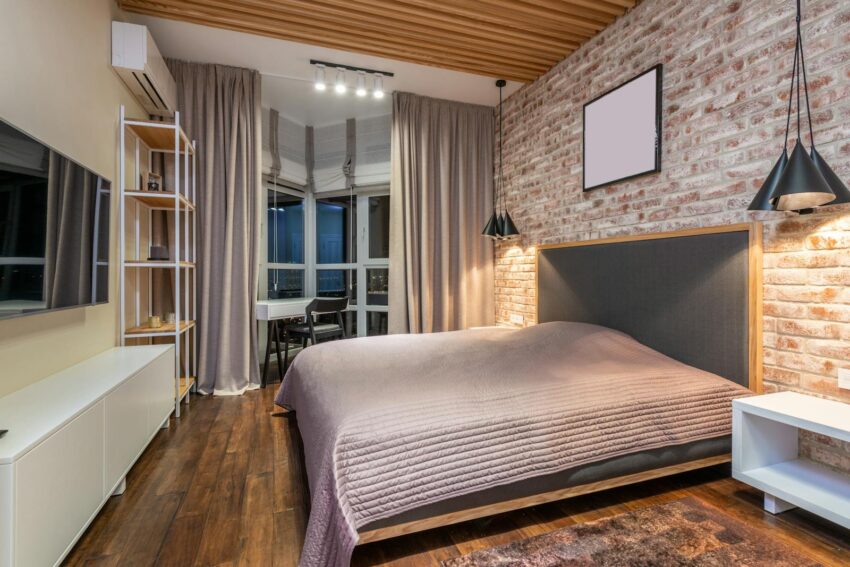Ceiling panels play a vital role in modern interior design. Not only do they provide functional benefits, but they also enhance your space’s overall look and feel. With architects and interior designers constantly pushing the boundaries of innovation, ceiling panels have become a must-have for any space. Whether to improve the overall ambience or acoustics, ceiling panels are one of the most versatile components in modern interiors.

Maximising Visual Impact
Ceiling panels play one of the most important functions in a room. Whether it’s through intricate patterns, vibrant colours, or cutting-edge materials, ceiling panels hold the power to grab your attention and create a focal point. Designers often strategically use ceiling panels to draw the eye upwards. This adds dimension and drama to plain surfaces. To maximise the visual impact of your ceiling panels, consider adding unique textures or patterns to complement your overall design scheme. Experimenting with lighting techniques can also increase the visual appeal of your ceiling panels. They can cast captivating shadows and highlights that add depth to your space.
Optimising Acoustics
Ceiling panels are not only aesthetically pleasing, but they also play an important role in improving acoustics in interior spaces. In offices, restaurants, and residential areas where noise control is important, acoustic ceiling panels help to reduce reverberation and enhance sound quality. Factors to consider when selecting ceiling panels for acoustical purposes include material density and thickness, as well as the texture of the surface. Panels that absorb sound, such as those with perforations or textures, are especially effective in reducing sound reflection and improving overall comfort.
Enhancing Thermal Insulation
In addition to their visual and acoustical benefits, ceiling panels can also help to improve thermal insulation in indoor spaces. By adding an extra layer of insulation above the floor, ceiling panels help to control temperature changes and increase energy efficiency. The best way to maximise thermal insulation is to select ceiling panels made of high-quality insulation materials and use the right installation methods. Consider integrating ventilation systems or radiant heating elements to improve indoor comfort and sustainability.
Creating Functional Zones
Ceiling panels can be used to create functional zones within larger indoor spaces. They can be used to delineate areas for particular activities or purposes. For example, they can be used to define areas for seating in a commercial space or to divide different areas within a residential space. When creating functional zones, ceiling panels can be visual markers to guide occupants and improve spatial organisation. When using ceiling panels for functional zones, it is important to consider using different heights, shapes or colours to differentiate different areas while keeping a consistent design aesthetic. Stripped or suspended ceiling panels and floating ceilings can also add visual interest and effectively delineate boundaries.
Promoting Sustainability
Now more than ever, sustainability is at the forefront of modern design. Whether looking for an eco-friendly ceiling panel or an energy-efficient installation, you’ll find sustainable design options to suit your needs. Choose a ceiling panel made from sustainable or recycled materials. For example, you can choose a reclaimed wood ceiling panel, a bamboo ceiling panel, or an acoustic fabric ceiling panel made from recycled fibre. Optimise energy efficiency with energy-saving lighting fixtures and install methods that reduce environmental impact while increasing performance and durability.
Integrating Smart Technology
As technology permeates every aspect of our lives, smart technology is increasingly incorporated into ceiling panels. From integrated LED lighting with adjustable settings to built-in speakers for an immersive audio experience, smart ceiling panels are becoming increasingly popular for interior design. Combining technology with design allows architects and designers to create spaces that are not only aesthetically pleasing but also provide greater comfort and connectivity to occupants.
Exploring Creative Applications
There’s no limit to how creative ceiling panels can be used in modern design. From sculptural ceiling panels as art pieces to interactive installations that react to user interaction, designers are pushing the boundaries of what is possible. They’re experimenting with materials, shapes, configurations, and more to create truly one-of-a-kind, impactful installations. By embracing creativity and pushing boundaries, designers can reimagine ceiling panels’ role in interior design. They can transform them from functional elements into works of art that evoke awe and admiration.
Redefining Interior Spaces
Ceiling panels are no longer just a functional piece of furniture. They have become a versatile design element that can transform any interior space in modern design. They can maximise visual impact, improve acoustics, increase thermal insulation, and promote sustainability. Ceiling panels play a multi-faceted role in creating contemporary interiors’ ambience, function, and aesthetics. With a wide variety of options in terms of material, texture, and installation methods, designers can use ceiling panels to create dynamic, exciting, and sustainable spaces that will delight and inspire occupants for generations to come.
